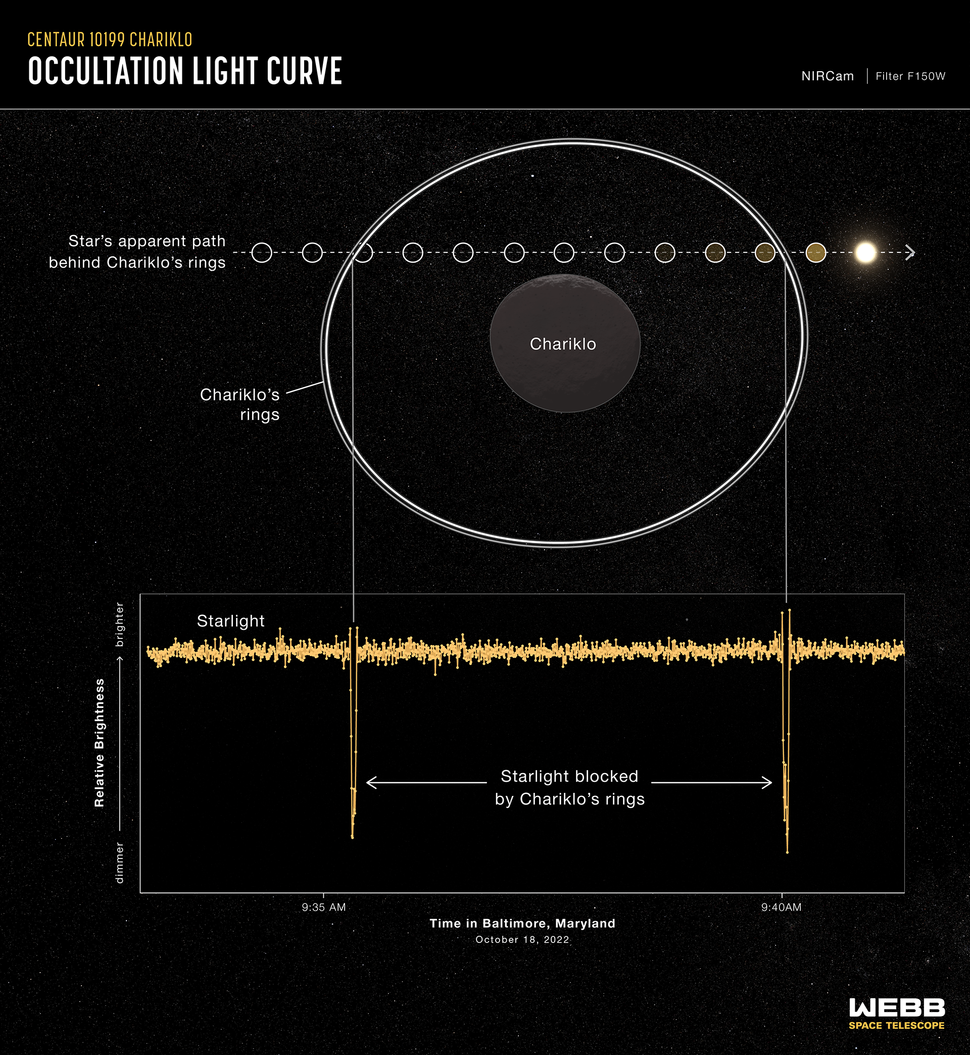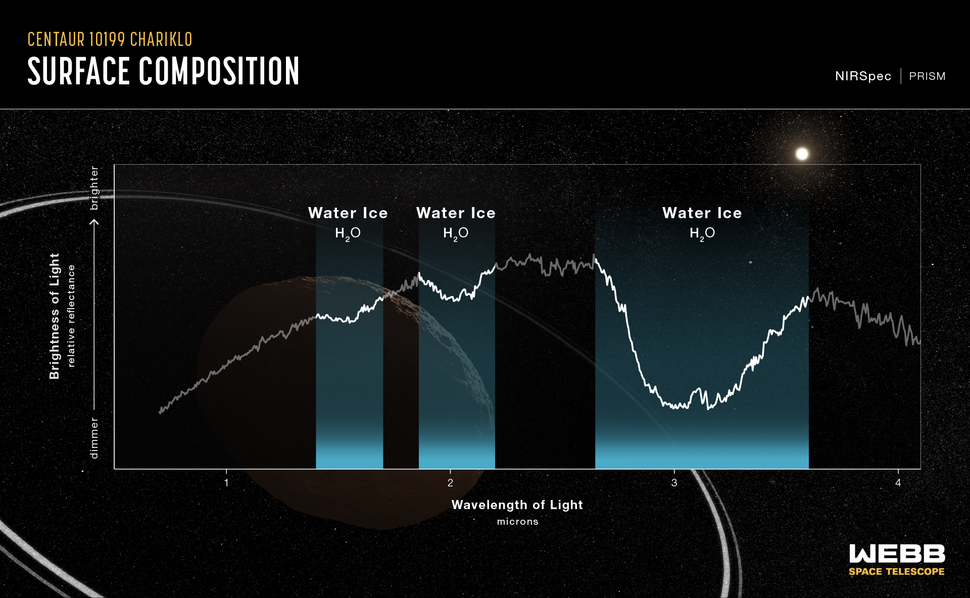
Posted on 01/27/2023 11:13:16 AM PST by Red Badger
The most comprehensive plans need a sprinkle of luck, even in space.
VIDEO AT LINK
In October 2022, the James Webb Space Telescope (JWST or Webb) watched as Chariklo, a tiny ringed asteroid, eclipsed a star. This event, called an occultation, marked a first for Webb. At the month's end, Webb turned toward Chariklo again and notched another victory: For the first time, astronomers analyzing the telescope's data spotted clear signs of water ice, the presence of which was only hinted at until now. These observations will guide astronomers to better understand the nature and behavior of tiny bodies in the outer reaches of our solar system.
But the two feats almost did not happen.

This illustration shows what the Centaur Chariklo and its rings could look like, based on our current understanding. (Image credit: NASA, ESA, CSA, Leah Hustak (STScI))
Although it is the largest of its kind, Chariklo is still too small and too far for even the mighty Webb to photograph directly. Instead, astronomers decided to study it through occultation, which is an indirect but powerful method to study small bodies like Chariklo. But the team did not know if and when a star — without which an occultation would not occur — would fall into Webb's field of view. This made Chariklo part of Webb's target of opportunity(opens in new tab) program: If the asteroid happened to cross in front of a star, the program would allow astronomers to temporarily interrupt the telescope's schedule to observe the event.
The team calculated only a 50% chance that Webb would spot a star bright enough with an interesting object like Chariklo crossing in front. After its launch in 2021, as Webb went through routine course corrections to hold it steady in its parking spot in space, the team continued predicting and revising its list of possible occultations. Late last year, astronomers ended up on the favorable side of that 50% when they discovered "by remarkable good luck" that Chariklo was on track to occult a star that also fell into Webb's view.
"This was the first stellar occultation attempted with Webb," the team wrote in a NASA statement(opens in new tab) published Wednesday (Jan. 25). "A lot of hard work went into identifying and refining the predictions for this unusual event."
On Oct. 18, 2022, Chariklo and its system of two rings crossed in front of a star. Using Webb's near-infrared camera (NIRCam), astronomers monitored the star's brightness for an hour. Resulting data showed two dips in the star's brightness as expected: When the asteroid's rings first hid the star as the eclipse began, and again when the last of its rings wrapped up the occultation.
"The shadows produced by Chariklo's rings were clearly detected," the team wrote in the statement, "demonstrating a new way of using Webb to explore solar system objects."

Graphic showing the dimming effects of Chariklo's rings on a background star. (Image credit: IMAGE: NASA, ESA, CSA, Leah Hustak (STScI) SCIENCE: Pablo Santos-Sanz (IAA-CSIC), Nicolás Morales (IAA-CSIC), Bruno Morgado (UFRJ, ON/MCTI, LIneA))
Objects like Chariklo are called centaurs, thanks to their hybrid nature. (Centaurs are mythological horse-human hybrids.) They look like asteroids but behave like comets — complete with visible tails. Their home, an unstable orbit between Jupiter and Neptune, hosts thousands of centaurs of varying shapes and sizes. As interesting as they are, their small size and vast distance make them difficult to study. The composition of even the biggest centaur, Chariklo — which is still tiny at just 160 miles (250 km) in diameter and distant at a whooping 2 billion miles (3.2 billion km) from us — is poorly understood. Also, past research hinted at water ice somewhere in Chariklo's system, but had yet to conclusively detect it.
In this latest research, astronomers pointed Webb at Chariklo again. This time, they used the telescope's Near-infrared Spectrograph (NIRSpec) instrument to measure the sunlight reflected by Chariklo and its two rings. The resulting spectrum showed three absorption bands of water ice, marking the first clear indication of crystalline ice.
The presence of crystalline ice likely indicates that Chariklo is subject to constant bombardment, according to Dean Hines, an astronomer at the Space Telescope Science Institute in Maryland. "Because high-energy particles transform ice from crystalline into amorphous states, detection of crystalline ice indicates that the Chariklo system experiences continuous micro-collisions that either expose pristine material or trigger crystallization processes," Hines said in NASA's statement.

Reflectance spectrum of the double-ringed centaur 10199 Chariklo, captured by Webb's Near-Infrared Spectrograph (NIRSpec) on Oct. 31, 2022. This spectrum shows clear evidence for crystalline water ice on Chariklo's surface. (Image credit: IMAGE: NASA, ESA, CSA, Leah Hustak (STScI) SCIENCE: Noemí Pinilla-Alonso (FSI/UCF), Ian Wong (STScI), Javier Licandro (IAC))
Astronomers have gotten one step closer to studying the Chariklo system, but there is still much that remains unknown about the centaur. The spectrum analyzed in the latest research includes information about the system as a whole, but at the moment, it is difficult to distinguish the data between Chariklo and its two rings.
For example, although astronomers spotted the first clear signs for crystalline water ice, they do not yet know for sure where in the asteroid's system the ice is present. In the coming months, researchers hope to use Webb's high sensitivity to dig up individual features of Chariklo and its two rings, Pablo Santos-Sanz, an astronomer at the Instituto de Astrofísica de Andalucía in Spain who took part in this research, said in the statement.
"We hope [to] gain insight into why this small body even has rings at all, and perhaps detect new fainter rings," Santos-Sanz said.
Ping!....................
We discovered frozen h2o which is a combination of 2 of the 3 most common elements in the universe!!! It’s super likely that it is also very cold in space which is why it is frozen!!! We work so hard!!!
They should be looking for lithium..................
Lithium is very scarce by comparison to any of the five most abundant elements in the universe. Lithium nuclei inside stars readily fuse with hydrogen to form carbon. There is not much lithium left when the star supernovas. This may be why liberals hate carbon so much.
Lithium is also used as a psychiatric medication........................😎
I have always been curious how much water stardust earth scoops up in orbit vs. how much it loses as hydrogen that escapes from the atmosphere. Is it a net loss or gain?
10199 Chariklo is the largest confirmed centaur. It orbits the Sun between Saturn and Uranus, grazing the orbit of Uranus. On 26 March 2014, astronomers announced the discovery of two rings around Chariklo by observing a stellar occultation, making it the first minor planet known to have rings. Wikipedia
Orbital period: 63 years
Radius: 93.827 mi.
Must be a net gain, or we would be bone dry as Dune by now!...................
Does the 93 mile radius include the rings or just the center mass? Anyone know?
Fascinating. Chariklo would make a good target for a probe, to gather samples of any material associated w/the asteroid to analyze, as well as do some visual imaging.
Hey, NASA…….
For a scientist, those “Relative Brightness” spikes in the Occultation Light Curve data can best be described as orgasmic...
Nice find! Thanks Red Badger.
Disclaimer: Opinions posted on Free Republic are those of the individual posters and do not necessarily represent the opinion of Free Republic or its management. All materials posted herein are protected by copyright law and the exemption for fair use of copyrighted works.